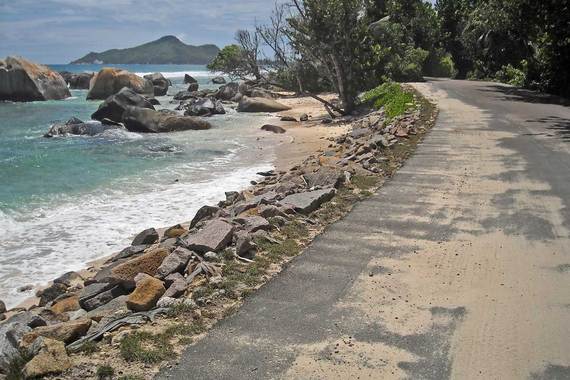After the Vatican, the world's smallest independent state is the Republic of Nauru -- a tiny island in Micronesia measuring about 8 square miles, roughly equivalent to one-tenth of greater Barcelona. The morning jog of a Nauruan resident could consist of crossing the island back and forth.
Over time Nauru could prompt a new world record of sorts: the smallest nation on earth to face up to the climate change Goliath which is currently threatening the very existence of around 50 Small Island Developing States (SIDS), with its ravaging cocktail of warmer, wilder weather and rising oceans, among other maladies.
The first step towards lasting change can happen as soon as next week. A milestone will unfold in Samoa from September 1-4 when the Third International Conference on the SIDS brings together dozens of heads of state and global leaders to address the many challenges these vulnerable states face.
SIDS are increasingly confronting issues linked to climate change and rising sea levels. These include: natural resource depletion, soil degradation, land and coastal pollution and, to top it all, stronger and more frequent storms capable of setting back the development clock by many years. In 2009, the Carteret Islanders of Papua New Guinea became the first community to be entirely displaced by climate change due to rising sea levels.
Drawing on lessons learned from a history of geographical, cultural and economic fragmentation, coupled with a complex colonial experience, island nations are rapidly getting better at working together. As a result, "partnerships" has become the conference's buzzword. Hundreds of registered participants are ready to describe how south-south, north-south and SIDS-SIDS collaboration are helping to set a positive course for island nations.
SIDS were first recognized in the context of the 1992 Earth Summit, the birthplace of the first international environmental convention for which my organization, the Global Environment Facility (GEF), has been serving as a financial mechanism ever since.
Vital Seas
Oceans will be prominent in Samoa, as renewed global attention to marine issues is also helping to place the SIDS under sharper focus.
Many want to be recognized as Ocean States so they can better focus their development strategies on the richness of their marine ecosystems. The average land area of a SIDS country is about 9,300 mi2 but their average EEZ is close to 270,000 mi2. So, for most island nations, wealth and natural capital are concentrated in their oceanic Exclusive Economic Zones (EEZs). Under the United Nations Law of the Sea, SIDS have both the acquired right and the opportunity to manage this huge area to benefit their people, and by doing so, contribute to the health of the global environment.
In order to realize this potential, SIDS must be empowered both politically and practically to manage this tremendous wealth in a sustainable manner. Nowhere is this relationship more evident than in management of fisheries and other marine resources. SIDS are quickly being equipped to prevent a large expanse of ocean -- some 20 percent of the global EEZs -- becoming like the dystopian Waterworld where finite resources are reaped by whoever holds most economic and technological power in a no-man's oceanscape.
Unhappy with the predatory harvesting of one of their greatest assets, tuna, Pacific Island nations have orchestrated a common plan to deal with rampant unsustainable practices. By setting common allowable catch limits at more sustainable levels and by better enforcing access rights to their EEZs, total annual revenues have quadrupled to $240 million/year since 1997.
Energy is another major priority. SIDS contribute very little to the build-up of greenhouse gases, however energy is a major expense that could be used more effectively for other development priorities.
For Aruba, 16 percent of GDP is taken up to import 6,500 barrels of diesel a day to generate electricity. And yet, SIDS are blessed by abundant renewable energy potential. Renewable energy sources, such as solar and wind, are ideally suited to larger islands as well as to the smallest and most remote corners of archipelago nations that would never economically justify being connected to an electrical grid.
For a large number of SIDS, the first four days of September could become the launch pad for new sustainable development paths. With the proper support from donors and technical assistance agencies, the Samoa conference may very well be all that is needed to unleash the true potential of these global gems of the ocean world.

